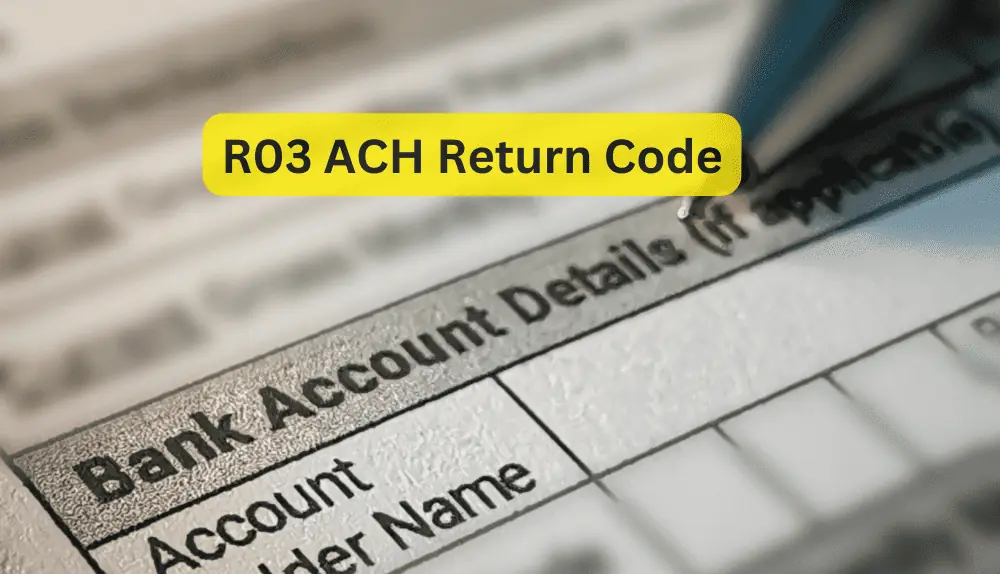In the intricate world of ACH payments, an enigmatic obstacle often arises in the form of the R03 return code. Serving as cryptic messages from the Automated Clearing House, these codes notify merchants of payment failures and the inability to locate or process an account. With a total of 85 different ACH return codes in existence, understanding the nature of R03 becomes crucial for businesses to tackle unapproved transfers promptly and effectively. Join us on a journey to decipher the mysteries of the ACH R03 return code and discover the key to a successful resolution.
What does R03 ACH Return Code Means?
ACH Return Code R03 indicates that the transaction has failed due to the inability to locate the recipient’s bank account. When an Automated Clearing House (ACH) payment is initiated, the receiving bank verifies the account information to ensure its validity. If the provided account number does not match any existing account or the account has been closed or is otherwise inactive, the ACH transaction is flagged with the R03 return code. This code serves as a notification to the sender, typically a merchant or organization, that the payment could not be completed as intended.

There are several reasons why an R03 return code may occur. It could be a simple clerical error, such as a mistyped account number, or the recipient might have closed their account without updating the information. It is also possible that the recipient’s account has been put on hold or restricted for some reason.
Resolving an R03 return code involves reaching out to the recipient to confirm their account details and address any discrepancies. The sender may also need to review their payment processing procedures to avoid future occurrences. Understanding the implications of ACH Return Code R03 is essential for businesses to manage their payments efficiently and maintain positive relationships with customers.
Reasons R03 ACH Return Code Can Occur
The ACH Return Code R03 can occur due to various reasons, all of which revolve around issues related to the recipient’s bank account or its availability. Some common reasons for the R03 return code include:
Incorrect Account Number
If the account number in the ACH transaction is incorrect or contains a typographical error, the receiving bank will not be able to locate the account, leading to the R03 return code.
Closed Account
When the recipient’s bank account is closed, the ACH transaction cannot be processed, resulting in an R03 return code.
Inactive Account
In case the account is inactive or dormant, the ACH payment will be rejected with the R03 return code.
Frozen or Restricted Account
A recipient’s account may have been frozen or restricted due to legal issues, fraud concerns, or other reasons preventing the successful completion of the ACH transaction.
Invalid Account Structure
The account number might not adhere to the proper structure/format required by the receiving bank, causing the transaction to fail.
Account Holder Information Mismatch
If the name of the account holder provided in the ACH transaction doesn’t match the name associated with the bank account, it can trigger an R03 return code.
Bank Routing Number Error
Incorrect or outdated routing numbers can lead to an R03 return code since the transaction will not reach the correct bank.
It is crucial for businesses and organizations to identify and address the reasons behind the R03 return code promptly to avoid payment delays and maintain efficient payment processing systems.
Solutions to Fix R03 ACH Return Code
The ACH Return Code R03 can cause frustration and delays for businesses and organizations seeking to process payments smoothly. To resolve this issue effectively, it is essential to identify the root causes behind the R03 return code and implement appropriate solutions. Below are several solutions that can help fix ACH Return Code R03 and ensure successful payment transactions:

Double-Check Account Information
The most common reason for the R03 return code is an incorrect or mistyped account number. To avoid this, businesses should implement rigorous validation processes for account information. Double-checking the account and routing numbers before initiating the ACH transaction can significantly reduce the occurrence of R03 return codes.
Update Account Information
Encourage customers and recipients to keep their account information up to date. This can be done through regular communication, reminders, or automated systems that prompt users to verify and update their account details periodically. This proactive approach helps prevent R03 return codes caused by closed or inactive accounts.
Verify Account Status
Before initiating an ACH payment, businesses should verify the status of the recipient’s account. Ensure the account is active and in good standing to minimize the risk of encountering an R03 return code due to frozen or restricted accounts.
Use Proper Account Structure
Ensure the account number adheres to the correct format required by the recipient’s bank. Different banks may have varying requirements for the structure of account numbers. By adhering to these guidelines, businesses can avoid potential R03 return codes stemming from invalid account structures.
Implement Name Matching
To prevent R03 return codes resulting from account holder name mismatches, consider implementing name matching mechanisms. These mechanisms compare the name provided in the ACH transaction with the name on file with the recipient’s bank. If there is a discrepancy, the system can prompt for verification or provide an opportunity to correct the information.
Communicate with Recipients
If an R03 return code occurs, businesses should promptly communicate with the recipient to resolve the issue. Provide clear instructions on how to update account information or address any discrepancies that might have caused the rejection. Open lines of communication can help expedite the resolution process.
Monitor Account Activity
Frequently monitor account activity to detect any potential issues that might lead to R03 return codes. Regularly reviewing payment transaction logs and account updates can help identify patterns or anomalies that need attention.
Offer Alternative Payment Methods
In cases where ACH payments consistently encounter R03 return codes with a specific recipient, consider offering alternative payment methods. Providing options like credit card payments or electronic wallets can ensure the recipient receives the funds while minimizing potential disruptions.
Stay Informed About Banking Changes
Stay updated on changes to banking regulations, account structures, and other relevant guidelines. Keeping abreast of industry updates can help businesses proactively adjust their payment processes to align with the latest requirements and reduce the likelihood of R03 return codes.
Automate Payment Processing
Automating the payment processing system can streamline the ACH payment process and minimize human errors that could lead to R03 return codes. Utilizing robust payment processing software can help validate account information, verify transaction details, and reduce the occurrence of return codes.
Overall, addressing the ACH Return Code R03 requires a combination of proactive measures and prompt responses when issues arise. By implementing these solutions, businesses, and organizations can improve the efficiency of their payment processes, minimize payment disruptions, and maintain positive relationships with the customers and partners. Regularly reviewing and optimizing payment procedures will not only reduce R03 return codes but also contribute to a more robust and reliable payment ecosystem.
Can R03 Return Code be Reversed or Reprocessed?
An R03 return code can be reversed or reprocessed after addressing the underlying issue that caused the rejection. When an Automated Clearing House (ACH) transaction encounters an R03 return code, it means that the payment was unsuccessful due to the inability to locate the recipient’s bank account. However, this code does not indicate a permanent failure, and there are steps that can be taken to rectify the situation.
To reverse or reprocess an ACH payment with an R03 return code, the following actions are typically required:
Identify the Issue
First and foremost, it’s essential to determine the reason behind the R03 return code. This could include verifying account number, checking for any discrepancies in account holder information, or ensuring the account is active and in good standing.
Contact the Recipient
Reach out to the recipient of the payment to inform them of the issue and request updated account information if necessary. It’s crucial to communicate promptly to avoid any delays in resolving the problem.
Update Account Information
If there was an error in the account details, ensure that the correct and accurate account information is obtained from the recipient. Make sure to double-check the new account details to avoid encountering the same issue again.
Reattempt the Transaction
Once the account information is verified and updated, the payment can be reprocessed with the corrected details. Ensure that all necessary adjustments are made in the payment processing system to prevent a recurrence of the R03 return code.
Monitor for Success
After reprocessing the payment, monitor the transaction to confirm it goes through successfully. Keep an eye on any subsequent notifications or return codes to ensure that the issue is fully resolved.
It’s important to note that while many R03 return codes can be resolved through the above steps, there may be cases where the issue is not easily fixable. For instance, if the recipient’s account is closed permanently or frozen due to legal reasons, reprocessing the payment may not be possible. In such cases, businesses may need to explore alternative payment methods or reach out to the recipient to find a suitable resolution.
Overall, an R03 return code is not a permanent blockage for payment transactions. By identifying the root cause, updating account information, and taking necessary corrective measures, businesses can often reverse or reprocess the ACH payment successfully, ensuring that the funds reach their intended destination without further complications.
Final Words
In conclusion, understanding and addressing the ACH Return Code R03 is crucial for businesses and organizations seeking smooth and efficient payment processing. By delving into the reasons behind this enigmatic return code, businesses can implement appropriate solutions to rectify payment failures promptly. From verifying account information and staying updated on banking changes to fostering open communication with recipients, these proactive measures ensure that ACH transactions flow seamlessly.
While encountering an R03 return code may initially pose challenges, the ability to reverse or reprocess payments after resolving underlying issues offers reassurance and flexibility. With a robust payment processing system and a proactive approach to managing payment details, businesses can navigate the intricacies of ACH payments with confidence, ensuring that funds reach their intended destinations while maintaining positive relationships with customers and partners.
Frequently Asked Questions (FAQs)
Why did I receive an ACH Return Code R03 on my payment?
You received an ACH Return Code R03 because there was an issue with the recipient’s bank account information. It could be due to an incorrect account number, a closed account, or discrepancies in the account holder’s information.
How can I resolve an ACH Return Code R03?
To resolve an ACH Return Code R03, you should first contact the recipient and verify their account details. If there are any discrepancies or errors, correct the information and reprocess the payment. Communication with the recipient is crucial to ensure the payment is processed accurately.
Can an R03 return code be due to a technical error or delay?
While it is possible for technical errors or delays to occur during the ACH payment process, the R03 return code specifically points to issues related to the recipient’s bank account. It is essential to verify the account information and resolve any account-related problems to address the R03 return code.
How can businesses prevent ACH Return Code R03 occurrences?
Businesses can prevent ACH Return Code R03 by implementing strong validation processes for account information before initiating ACH transactions. Encouraging customers to keep their account details up-to-date and verifying account status can also minimize the risk of encountering R03 return codes.
Can ACH Return Code R03 be caused by a one-time mistake?
Yes, ACH Return Code R03 can occur due to simple clerical errors, such as mistyped account numbers or incorrect account information. However, it can also be caused by more significant issues, such as closed accounts or frozen accounts, which may require additional steps to resolve.

